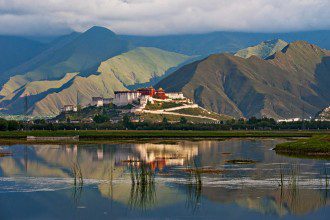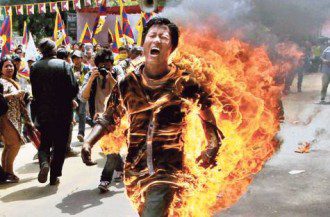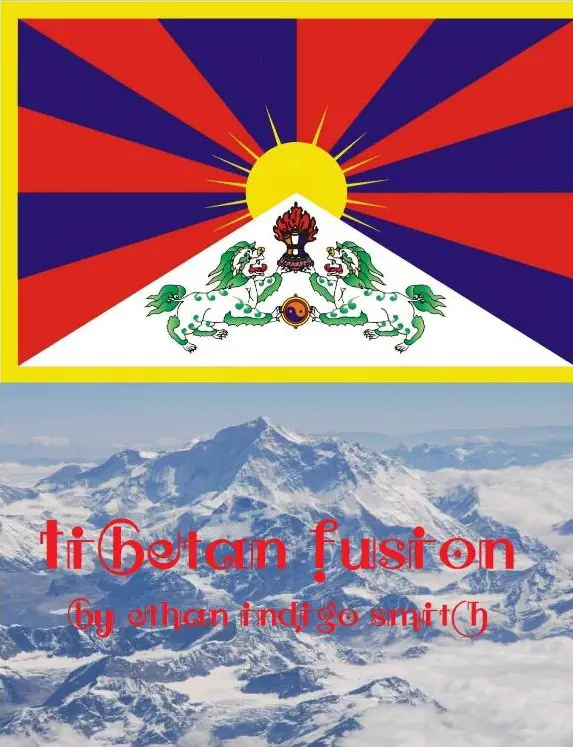Contributing Writer for Wake Up World
The word ‘tantra’ signifies confluence and integration; a fusion. Sanskrit for “loom”, a device which weaves together string into cloth, tantra is an ancient word with many properties and uses; it has been variously used to describe the knots of strings weaved together in a rug, and the cord on which sacred mala bead necklaces were strung. (Mala beads are Tibetan prayer necklaces of 108 beads used to assist mentally or vocally repeating a mantra 108 times.) Today the word tantra is often used in reference to the union of lovemaking.
More broadly, however, tantra notes a mutually accepted connection, a tied knot of intertwined being, like lovemaking, but not necessarily beginning with or limited to it. Humanity itself is a tantra; a fused weaving knot or many strings.
Essentially, tantra is spiritual understanding of the relationship between individuation and connection. An ancient spiritual philosophy preceding both Buddhism and Hinduism, tantra represents integration, unifying the macrocosm with the microcosm, the universal and the individual, the feminine and the masculine, the yin and the yang. It can also refer to integrative knowledge and its continuation and building through the interaction of teacher and student, signifying union and fusion; the acceptance, integration and transmutation of knowledge between individuals, like the string of life.
Tantra should not be confused with yantra yoga from Tibet, or yantras, the sacred geometric symbolism, just as the practice of yoga should not be confused with being simply asanas or physical postures. Yantra yoga is one of the oldest forms of yoga and because of the environmentally foreboding nature of Tibet and the varying secretive cultures of most meditative movements, it is said to be one of the purest and least altered forms of yoga. Yantra yoga concentrates on moving into and out of asanas with the breath, as opposed to being in a position for multiple breaths. However tantric ideas are metaphysical; the merging of the physical and spiritual. In essence, Tantra is the integration of yantra (a philosophy and visual symbol), mantra (oral communication) and mudra (meaning “gesture”, a physical positioning) — each of which is important intertwined aspect of yoga, and life.
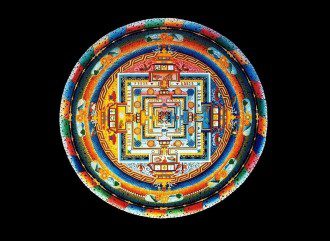
A Yantra, the sacred symbolism representing the Geometry of Energy.
Teachers and Gurus
In the past a teacher or guru was a requirement for such esoteric instruction. Today there are not enough gurus relative to those who seek instruction, but there are also more ways to learn more practices than ever. For example, Tapping and Tai Chi, the 5 Tibetan Rites of Rejuvenation, and simple meditative practices are accessible foundational techniques that require little guidance. (Click the links for a guided introduction to each practice.)
The difference between a teacher and a guru is that gurus so profoundly embody a teaching or philosophy that merely being in their presence imparts answers without questioning. A guru has the ability to teach, learn and share spiritual and meditative knowledge, but also has the power to transmit a comforting presence, even a sense of bliss. Ideally we would all have gurus, not so that we are shown what path to follow, so that – with knowledge and comfort – we can come to know where we are going as we proceed on our own path, becoming powerful individuals on our own, aided by the wisdom and grace of those who have gone before us (without having to reinvent the wheel with each generation.) They are akin to the elders and healers of other ancient cultures, whose role is to share knowledge and pass esoteric wisdom on to others in their tribe.
Today in Tibet and the rest of the world, the number of empowered individuals – the teachers and gurus – is eclipsed by the number of institutionalized individuals who might benefit from their wisdom. In times past, the wisdom of gurus was sought by seekers of the highest order, but today, in this process of human ascension, the seekers’ numbers are rapidly growing. The institutionalized greatly outnumber the individuated; most of us are under the thumb of authorities, busy tending to survival within social constructs rather than building lives of individuation, later realizing the need to climb the mountain of enlightenment.
Om Mani Padme Hum ~ The mantra of Tibet has complex meaning suggestive of individual and universal connection, and is an invocation of benevolence and compassion.
The Plight of Tibet
Like the tantra, Tibet itself is a land of confluence, a land of intermingling cultures, ideas and ancient philosophies. Tibet and the surrounding region is a land of integration, where meditation practitioners spent most of their time in seclusion so as to develop their mind, body and spirit in the pursuit of oneness, of fusion with all that is. These yogis and wise gurus are capable of amazing feats, not the least of which was simply surviving in the extreme elevation Himalayan cold without heat or modern protections from the harsh mountainous elements. One of the first higher meditative practices in the esoteric Tibetan Buddhist yoga practice called Naropa yoga is the practice of inner fire, the creation of psychic heat, or Tummo.

Displaying of “Free Tibet” banners and the Tibetan National flag is restricted by Chinese law in Nepal.
But today, Tibet’s gurus and the power of their inner heat have been overwhelmed, scattered by repressive authorities, driven from Tibet — along with their ancient philosophies — and driven to submission by the worldly ways of national and cultural institutions. The International Campaign for Tibet describes the factors at play succinctly:
Tibetans are denied the space to develop and express their distinct culture and identity as the Chinese government’s vision of progress and development takes shape in Tibet… China’s economic policies in Tibet are based on a political agenda that fails to consider Tibetan needs, views, and livelihoods…
Tibetans cannot freely study and practice their religion. Government restrictions on celebrating important Buddhist anniversaries and required denunciations of the Dalai Lama further demonstrate the exclusion of Tibetans from the decision making process that determines the practices of their daily lives…
Sadly, the gurus of Tibet who carry the wisdom of their forebears have been disenfranchised or eliminated, in the same way as the spiritual teachers of most of the world. It is just more recent and perhaps most starkly apparent in Tibet. While it is one of many places to be occupied by force, the forceful institutionalization of such a profoundly spiritual nation like Tibet is a distinct horror, revelatory of how low the priorities of humanity societies have sunk. The indigenous Tibetans have undergone forceful gentrification and destruction, as is typical of all institutional takeovers. The Chinese institutions are dominating and destroying the Tibetan culture of monastic mountain retreat, and societies around the world have allowed the apartheid-like rule of Tibet to happen without ever catalyzing a proactive political strategy or boycott of the Chinese aggressors.
Perhaps if Tibet was rich in oil resources, the West would be more interested. Perhaps if we were all less concerned with the materialistic and more interested in the fantastic, we would all be more interested.
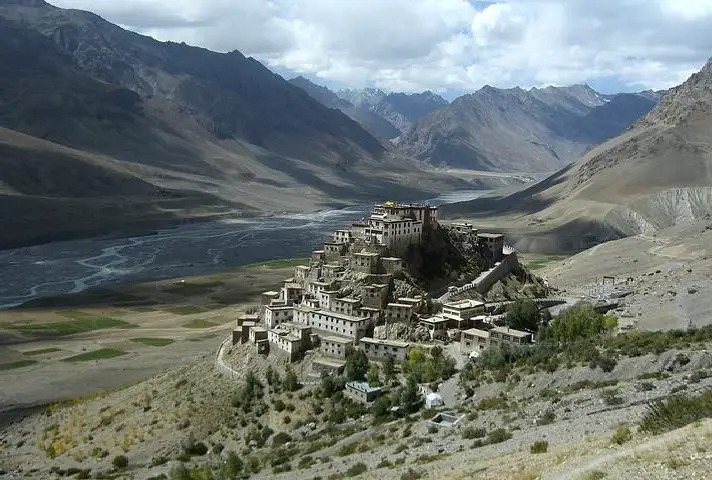
Key Gompa Monastery is a 1000 year old Tibetan Buddhist monastery located at an altitude of 4,166 meters (13,668 feet) in Tibet’s Spiti Valley.
Where Imperialism and Spirituality Collide
Allowing one of the most spiritual and compassionate nations to ever exist is a sad example of the postmodern collective gone astray; of worldlings lacking spirituality, hungry and distracted by the mechanics of institutional imperialism. Given the state of our world today, we ought to assist and uphold those who seek to live concentrating on spiritual development. This was the way of Tibetan culture, which supported the pursuits of the monastic. But today in China there is rampant religious repression of Tibetan Buddhism, and Falun Gong, and Christianity, and likely any belief system that officials see as a potential threat or outlet for a threat to their institutional hierarchy.
Such cultural repression stems from the fact that spiritual devotion leads to individuation, to individual empowerment and, therefore, ultimately to the empowerment of the human collective. Institutions, including but not limited to China, would prefer to keep everyone in their domain controlled, quiet and unaware of their individual potential. Similarly, many martial arts have been deliberately changed over time so as to not allow people to develop their fighting ability, sure, but also to prevent them from gaining the potential metaphysical understandings inherent in their practice as well. Tai chi, for instance, has many times been transformed from an internal/metaphysical martial art – a tantra – to simple exercise, reducing the results and hiding its potential.
As I said, devoted practice to tantric principles leads to individuation, the opposite of imperial institutionalization.
Gate Gate Paragate Parasamgate Bodhi Svaha ~ the Heart Sutra, meaning “Gone, gone, gone beyond, gone completely beyond, enlightened, so be it.”
China recently enacted laws essentially taking over Tibetan Buddhist monasteries and instituting government officials at the few remaining monasteries, seeking instead to turn monasteries into propaganda centers for Chinese Communist philosophy. China also recently enacted a law attempting to limit Tibetan Buddhist reincarnation without government permission, and claiming the right to decide who is the next reincarnation of the Dalai Lama.
In reality, the Chinese involvement in Tibet was no short of a military takeover. In October 1950, China’s People’s Liberation Armyentered Tibet, defeating minor resistance from the Tibetan army, killing countless Tibetans, destroying thousands of monasteries. And China has remade the nation of Tibet as theirs ever since. Some Tibetans, cornered by rigid oppression, have resorted to self-immolation – the act of public self-sacrifice – in order to call attention to the corruption and gentrification of their culture. Many have set themselves on fire to raise awareness of their exploitation and cultural elimination, in the most desperate form of protest we have seen in modern history.
Traditionally, Tibet is a land of indigenous integration; the mountainous crossroads of Asia. Tibet was a spiritual nation, one of tantra and sharing, where many spent their entire lives dedicated to the spiritual journey and those around them supported them. This contrasts starkly to societies throughout most of the world today, that selfishly pursue materialistic and competitive goals, where assisting the spiritual development of others let alone following one’s own spiritual path are not primary considerations for most people; and in some cultures, like our own, derided.
The Dalai Lama — literally translated as “Ocean Guru” — the spiritual leader of Tibet is not chosen but rather found through spiritual predictions and tests concerning his lineage, not through familial heritage but through reincarnation. A custodian of wisdom, each Dalai Lama is believed to be the reincarnation of the great spiritual teacher, Avalokitesvara, the Bodhisattva of Compassion. The current Dalai Lama, Tenzin Gyatso, is the 14th reincarnation of Avalokitesvara, identified in 1935 by a member of the Tibetan monastery in a vision that led to his discovery.
Despite losing his homeland and despite his people being dispersed, and worse, the Dalai Lama remains positive, for even though Tibetan Buddhism is being restricted in Tibet by the encroaching imperialism of China it has been freed to the world. Its teaching, philosophies, tantras, mantras yantras and mudras have struck a chord of resonance with spiritual seekers the world over. One reason, among many, is that Buddhism holds the distinction of being the only established religion that does not claim to define the creator of life (known variously as God, Allah etc.) nor offer access to the creator through any “one true faith” — a ridiculous notion when one considers the common origins of religions and theologies. Distinguishing it from other religions, Buddhism is built on philosophies of life and enlightenment, not authorship of life itself. The central figure in Buddhism, both traditional (Theravada) and Tibetan, is not a creator but a philosopher, a bodhisattva, a being of bodhi (enlightenment) and universal compassion. Its teachings can therefore be accessed without submission to the “higher” external power extolled by other religious doctrines, but through the exploration of consciousness and being. This is where the gurus and teachers become an invaluable part of the process.
The idea of an “ocean guru” might be at first confusing, especially from the mountains of Tibet. However the ocean symbolizes consciousness, the ethereal force everywhere of which we are but a drop — though within us is an ocean unto ourselves. It represents our interconnection — the tantric element that binds all aspects of life.
This idea also reminds me of aspects of many meditations, Buddhist and otherwise, where one imagines being a conduit of compassion, ultimately visualizing that compassionate energy eventually crossing the oceans. One way I learned this is to meditate and imagine that your loving presence emanates and extends across the oceans. Begin with imagining the removal of suffering and instilling happiness to all sentient beings thirty miles beyond you, then three hundred miles, then throughout your continent, then across the ocean nearest you, then all oceans and then the whole world, and beyond. In order to really benefit from any meditation and meditative movement it’s important to include such compassionate thinking in your practice.
Ong Namo Guru Dev Namo ~ meaning “I call upon the Divine Wisdom and bow to this Wisdom.”
In Tibet and across much of Asia, reincarnation is considered to be a fact that science cannot yet explain, a simple process of spiritual evolution. There are numerous instances of children knowing information which could indeed be explained in no other way but reincarnation and remembering past life experience, as well as other “extraordinary” psychic powers. Locating the next reincarnation of the Dalai Lama always requires psychic predictions of sorts. No other communist or democratic nation in the world has upheld such spiritual transition of power in modern times, or perhaps ever.
Most all national and imperial institutions keep power in the family or transfer it through another form of oligarchy, rather than through spiritual transition. Almost all national institutions act primarily to maintain and obtain power, resulting in war states, buffer states and ever-changing borders. The U.S. doctrine and history of perpetual war is a perfect example. Nations frequently act out of fear of loss as well as striving for potential gains. China took over Tibet when England left India and Tibet no longer was useful as a buffer state. Until then, Tibetans walked or rode horses wherever they went, respecting a prophecy which stated that, when the wheel comes to Tibet the nation would fall — a prophecy that was fulfilled. China took over Tibet like so many other nations have taken over so many other spiritual places; like England took over India, and the European nations took over the indigenous tribal cultures around the entire world. Through centuries of colonialism, imperial nations have decimated not just the sovereignty and cultural identity of nations like Tibet, but also the spiritual heritage and wisdom on which they were built.
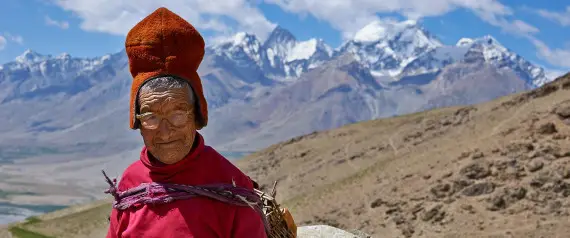
A Tibetan Buddhist nun from the The Tibetan Nuns Project, providing basic humanitarian aide to refugees from Tibet in India.
Crossroads
Tibet is an incredibly rich cultural fusion. It is a place of mountain isolation and alternatively a place of integration at the crossroads, where it’s said your hand in the sun can burn while your other hand in the shade is frostbitten. Great Indian gurus travelled to China via Tibet and likewise great Chinese philosophers and physicians went to India via Tibet. Even the legendary Mongolian armies came to Tibet as did people from the Muslim world and throughout Asia. Tibet is the Himalayan roof of the world and to a large extent, it was the center of the ancient world.
When Buddhism reached the Himalayan Mountains of Tibet from India, it was integrated with ideas in the shamanistic Bonn religion, the prominent form of worship in Tibet. In Tibet the indigenous Bonn ideas, Buddhism, some Hindu beliefs, some Taoist and Chinese influences and other cultural philosophies were all variously merged together and fused into Tibetan Buddhism. Tibetan Buddhism, like all Buddhism, is based on compassion for all sentient beings and embraces many esoteric philosophies and practices of legendary mountain yogis.
Instead of passively allowing the decimation of this ancient and enlightened culture, it is our duty in the West to stand up and uphold its sovereignty, to learn from its traditions and respect its ancient teachings; not only because it is the right thing to do, but because of what Tibet and its philosophy and history represents, as humanity itself stands at the crossroads between imperialism and spirituality.
Lokah Samastah Sukhino Bhavantu ~ meaning “May all beings everywhere be happy and free, and may the thoughts, words, and actions of my own life contribute in some way to that happiness and freedom for all.”
To learn more, visit The International Campaign for Tibet website.
Tibetan Fusion
Ethan Indigo Smith’s book “Tibetan Fusion” is an exploration of meditative movements that work by themselves, and together form a comprehensive way to develop your natural energy.
Combining elements of a variety of meditative practices and self-healing techniques (including Yoga, Tai Chi, Chi Gung and The Five Tibetan Rites of Rejuvenation, Tibetan Fusion provides a “map” of the body’s overall energy landscape with specific directions to help you achieve heightened energy, balance, strength and inner well-being — all without equipment or a “master”.
Tibetan Fusion is available here on Amazon.
Previous articles by Ethan Indigo Smith:
- The Common Origin of Religions and Theology
- Mutually Agreed Peace: Ending The Doctrine of Perpetual War
- The 5 Tibetan Rites of Rejuvenation: 108 Movements to a Meditative Mind State
- Idiots, Zealots, Elitists and Patriots: The Four “Wise Monkeys” of Modern Society
- Marijuana Prohibition and The Suppression of The Divine Feminine
- Meditation 108: A Guide to Meditating for the Infant Practitioner
- Is Matriotism The Future of The Divine Feminine? (w/Andy Whiteley)
- A Little Green Revolution: the Rainbow Warriors will Heal the Earth Mother
- Why Governments Promote Deadly Nuclear Energy and Ban Beneficial Hemp
- Hate: The Ultimate Social Control Mechanism
- The Healing Benefits of Tapping and Tai Chi
About the author:
 Activist, author and Tai Chi teacher Ethan Indigo Smith was born on a farm in Maine and lived in Manhattan for a number of years before migrating west to California. Guided by a keen sense of integrity and humanity, Ethan’s work is both deeply connected and extremely insightful, blending philosophy, politics, activism, spirituality, meditation and a unique sense of humour.
Activist, author and Tai Chi teacher Ethan Indigo Smith was born on a farm in Maine and lived in Manhattan for a number of years before migrating west to California. Guided by a keen sense of integrity and humanity, Ethan’s work is both deeply connected and extremely insightful, blending philosophy, politics, activism, spirituality, meditation and a unique sense of humour.
Ethan’s publications include:
- The Complete Patriot’s Guide to Oligarchical Collectivism, an insightful exploration of history, philosophy and contemporary politics.
- The Geometry Of Energy: How To Meditate, an empowering four step meditation that promotes individuation and understanding by way of the four dimensions.
- The Matrix of Four, The Philosophy of the Duality of Polarity on the subject of the development of individual consciousness.
- 108 Steps to Be in The Zone a set of 108 meditative practices for self discovery and individual betterment, including techniques to develop balance, transmute sexual energy.
For more information, visit Ethan on Facebook and check out Ethan’s author page on Amazon.

If you've ever found value in our articles, we'd greatly appreciate your support by purchasing Mindful Meditation Techniques for Kids - A Practical Guide for Adults to Empower Kids with the Gift of Inner Peace and Resilience for Life.
In the spirit of mindfulness, we encourage you to choose the paperback version. Delve into its pages away from screen glare and notifications, allowing yourself to fully immerse in the transformative practices within. The physical book enriches the learning process and serves as a tangible commitment to mindfulness, easily shared among family and friends.
Over the past few years, Wake Up World has faced significant online censorship, impacting our financial ability to stay online. Instead of soliciting donations, we're exploring win-win solutions with our readers to remain financially viable. Moving into book publishing, we hope to secure ongoing funds to continue our mission. With over 8,500 articles published in the past 13 years, we are committed to keeping our content free and accessible to everyone, without resorting to a paywall.

